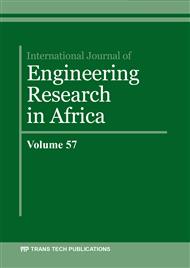[1]
Atashgahi S, Aydin R, Dimitrov MR, Sipkema D, Hamonts K, Lahti L, Maphosa F, Kruse T, Saccenti E, Springael D, Dejonghe W (2015) Impact of a wastewater treatment plant on microbial community composition and function in a hyporheic zone of a eutrophic river. Scientific reports 5:17284.
DOI: 10.1038/srep17284
Google Scholar
[2]
Rusanov AG, Khromov VM (2016) Longitudinal distribution of periphyton algae in the Moskva River under eutrophication. Water resources 43:513-521.
DOI: 10.1134/s0097807816030131
Google Scholar
[3]
Tyagi B, Kapoor R, Sinha D, Bhargava DS (2012) Mathematical Modeling and Simulation for Predicting DO Condition in Rivers. International Journal of Environmental Protection 2:29-34.
Google Scholar
[4]
Xia R, Zhang Y, Critto A, Wu J, Fan J, Zheng Z, Zhang Y (2016). The potential impacts of climate change factors on freshwater eutrophication: implications for research and countermeasures of water management in China. Sustainability, 8(3): 229.
DOI: 10.3390/su8030229
Google Scholar
[5]
Bailey RT, Ahmadi M (2014) Spatial and temporal variability of in-stream water quality parameter influence on dissolved oxygen and nitrate within a regional stream network. Ecological modelling 277:87-96.
DOI: 10.1016/j.ecolmodel.2014.01.015
Google Scholar
[6]
Temkin A, Evans S, Manidis T, Campbell C, Naidenko O. V (2019). Exposure-based assessment and economic valuation of adverse birth outcomes and cancer risk due to nitrate in United States drinking water. Environmental research, 176: 108442.
DOI: 10.1016/j.envres.2019.04.009
Google Scholar
[7]
Kannel PR, Lee S, Lee YS, Kanel SR, Pelletier GJ (2007) Application of automated QUAL2Kw for water quality modeling and management in the Bagmati River, Nepal. ecological modelling 202:503-517.
DOI: 10.1016/j.ecolmodel.2006.12.033
Google Scholar
[8]
Aissa-Grouz N, Garnier J, Billen G, Mercier B, Martinez A (2015) The response of river nitrification to changes in wastewater treatment (The case of the lower Seine River downstream from Paris). In Annales de Limnologie-International Journal of Limnology 51:351-364.
DOI: 10.1051/limn/2015031
Google Scholar
[9]
Nowka B., Daims H, Spieck, E (2015). Comparison of oxidation kinetics of nitrite-oxidizing bacteria: nitrite availability as a key factor in niche differentiation. Applied and environmental microbiology, 81(2): 745-753.
DOI: 10.1128/aem.02734-14
Google Scholar
[10]
Donner SD, Coe MT, Lenters JD, Twine TE, Foley, JA (2002) Modeling the impact of hydrological changes on nitrate transport in the Mississippi River Basin from 1955 to 1994. Global biogeochemical cycles 16:16-22.
DOI: 10.1029/2001gb001396
Google Scholar
[11]
Tisseuil C, Wade, AJ, Tudesque L, Lek S (2008) Modeling the stream water nitrate dynamics in a 60,000-km European catchment, the Garonne, southwest France. Journal of environmental quality 37:2155-2169.
DOI: 10.2134/jeq2007.0507
Google Scholar
[12]
Pohlert T, Huisman JA, Breuer L, Frede HG (2005) Modelling of point and non-point source pollution of nitrate with SWAT in the river Dill, Germany. Advances in Geosciences 5:7-12.
DOI: 10.5194/adgeo-5-7-2005
Google Scholar
[13]
Sui Y, Frankenberger JR (2008) Nitrate loss from subsurface drains in an agricultural watershed using SWAT2005. Transactions of the ASABE 51:1263-1272.
DOI: 10.13031/2013.25243
Google Scholar
[14]
Oeurng C, Cochrane TA, Arias ME, Shrestha B, Piman T (2016) Assessment of changes in riverine nitrate in the Sesan, Srepok and Sekong tributaries of the Lower Mekong River Basin. Journal of Hydrology: Regional Studies 8:95-111.
DOI: 10.1016/j.ejrh.2016.07.004
Google Scholar
[15]
Yin Y, Jiang S, Pers C, Yang X, Liu Q, Yuan J, Yao M, He Y, Luo X, Zheng Z (2016) Assessment of the spatial and temporal variations of water quality for agricultural lands with crop rotation in China by using a HYPE Model. International journal of environmental research and public health, 13:336-342.
DOI: 10.3390/ijerph13030336
Google Scholar
[16]
Lam QD, Schmalz, B, Fohrer N (2010) Modelling point and diffuse source pollution of nitrate in a rural lowland catchment using the SWAT model. Agricultural Water Management, 97: 317-325.
DOI: 10.1016/j.agwat.2009.10.004
Google Scholar
[17]
Wadi AS, Dimian MF, Ibrahim FN (2014) Analytical solutions for one-dimensional advection–dispersion equation of the pollutant concentration. Journal of earth system science 123:1317-1324.
DOI: 10.1007/s12040-014-0468-2
Google Scholar
[18]
Kumarasamy MV (2015) Deoxygenation andReaeration Coupled hybridMixing cells Based Pollutant Transport Model to Assess Water Quality Status of a River. International Journal of Environmental Research, 9:341-350.
Google Scholar
[19]
Olowe KO, Kumarasamy M (2017) Development of the hybrid cells in series model to simulate ammonia nutrient pollutant transport along the Umgeni River. Environmental Science and Pollution Research 24:22967-22979.
DOI: 10.1007/s11356-017-9916-2
Google Scholar
[20]
Ghosh N (2001) Study of solute transport in a river. Ph. D thesis, Dept of Civ. Eng., IIT. Roorkee, INDIA.
Google Scholar
[21]
Saggar S, Jha N, Deslippe J, Bolan N. S, Luo J, Giltrap D. L, Tillman R. W (2013). Denitrification and N2O: N2 production in temperate grasslands: Processes, measurements, modelling and mitigating negative impacts. Science of the Total Environment, 465, 173-195.
DOI: 10.1016/j.scitotenv.2012.11.050
Google Scholar
[22]
Kumarasamy M, Ghosh NC, Mishra GC, Kansal ML (2013) Hybrid model development for the decaying pollutant transport in streams. International Journal of Environment and Waste Management, 12:130-145.
DOI: 10.1504/ijewm.2013.055589
Google Scholar
[23]
Kinnunen K, Nyholm B, Niemi J, Frisk T, Kylä-Harakka T, Kauranne T (1982) Water quality modelling of Finnish water bodies. Vesihallitus. National Board of Waters.
Google Scholar
[24]
Brown LC, Barnwell TO (1987) The enhanced stream water quality models QUAL2E and QUAL2E-UNCAS: Documentation and user manual (p.189). US Environmental Protection Agency. Office of Research and Development. Environmental Research Laboratory.
Google Scholar
[25]
Ghosh NC, Mishra GC, Kumarasamy M (2008) Hybrid-cells-in-series model for solute transport in streams and relation of its parameters with bulk flow characteristics. Journal of Hydraulic Engineering, 134:497-502.
DOI: 10.1061/(asce)0733-9429(2008)134:4(497)
Google Scholar
[26]
Etemad-Shahidi A, Taghipour M (2012) Predicting longitudinal dispersion coefficient in natural streams using M5' model tree. Journal of hydraulic engineering 138:542-554.
DOI: 10.1061/(asce)hy.1943-7900.0000550
Google Scholar
[27]
Hill AR, Kemp WA, Buttle JM, Goodyear D (1999) Nitrogen chemistry of subsurface storm runoff on forested Canadian Shield hillslopes. Water Resources Research 35:811-821.
DOI: 10.1029/1998wr900083
Google Scholar


